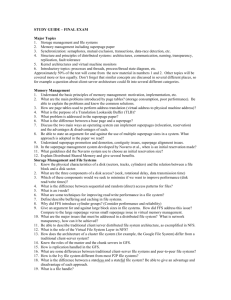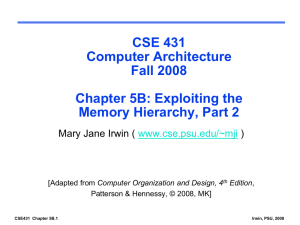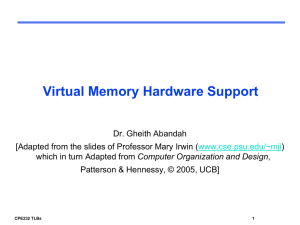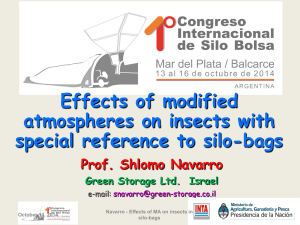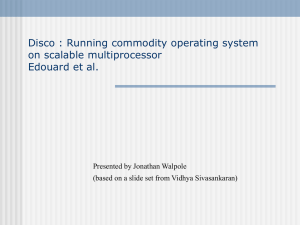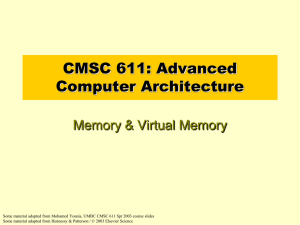Practical, transparent operating system support for superpages
advertisement
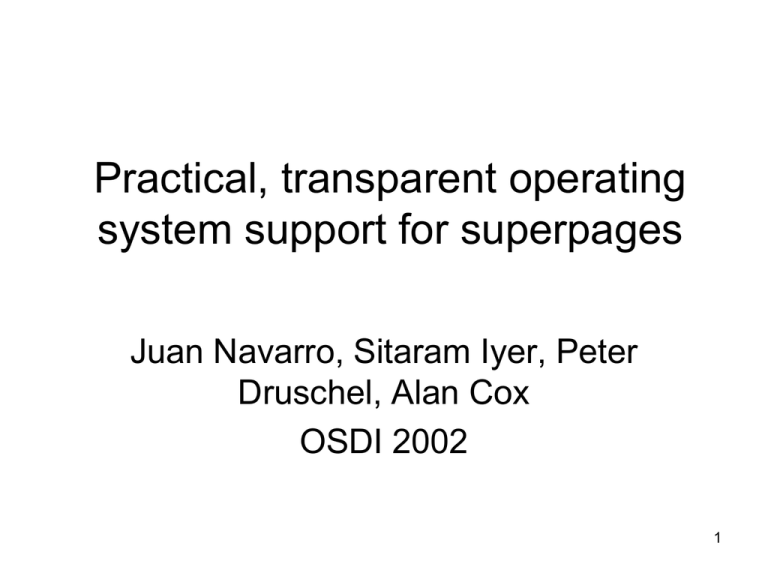
Practical, transparent operating system support for superpages Juan Navarro, Sitaram Iyer, Peter Druschel, Alan Cox OSDI 2002 1 What’s a Superpage? • A very large page size, much greater than the base page size • Supported by most computer architectures today • Machines that support superpages usually have several different page sizes, beginning with the base page and then in increasing sizes, each a power of 2 – today, some as large as a gigabyte. 2 Background Summary • Virtual memory automates the movement of a process’s address space (code and data) between disk and primary memory. • Virtual addresses are translated using information stored in the page table. • Page tables are stored in primary memory. • Extra memory references due to page table degrades performance 3 Translation Lookaside Buffer • TLB (translation lookaside buffer) – faster memory; caches portions of the page table • If most memory references “hit” in the TLB, the overhead of address translation is acceptable. • TLB coverage: the amount of memory that can be accessed strictly through TLB entries. 4 The Problem • Computer memories have increased in size faster than TLBs. • TLB coverage as a percentage of total memory has decreased over the years. – At the time this paper was written, most TLBs covered a megabyte or less of physical memory – Many applications have working sets that are not completely covered by the TLB • Result: more TLB misses, poorer performance. 5 The Solution • Superpages! • Increase coverage without increasing TLB size. • How? – By increasing amount of memory each TLB entry can map 6 Hardware-Imposed Constraints • Must have enough contiguous free memory to store each superpage • Superpage addresses (physical and virtual) must be aligned on the superpage size: e.g., a 64KB SP must start at address 0, or 64KB, or 128KB, etc. • TLB entry only has one set of bits (R, M, etc.) and thus can only provide coarse-grained info – not good for efficient page management. 7 Design Issues • Issues for a superpage management system: – Storage allocation and fragmentation control – Promotion – Demotion – Eviction 8 Issues: Frame Allocation • When a page fault occurs, must choose a frame for the new page – In non-superpage systems any frame will do – In a superpage system we may later decide to include this page in a superpage – how does this affect the decision? • Possible approaches to allocation: – Reservation based – Relocation based 9 Reservation-based Allocation • When a page is initially loaded choose a superpage size and reserve aligned, contiguous frames to hold it. – As other pages are referenced, load them into the previously reserved frames • Will adjoining pages ever be needed by the program? 10 Object mapping Mapped pages Virtual address space Superpage alignment boundaries Physical address space Allocated frames Unused page frame reservation Figure 2: Reservation based allocation 11 Relocation-based Allocation • Wait until a superpage is formed, then move pages to contiguous locations – Incurs overhead of moving pages when superpages are created. • Tradeoff: relocation costs versus unused reservations (internal fragmentation) 12 Choosing a Page Size • Regardless of whether reservation-based or relocation-based allocation is used, size of superpage must be chosen also. • When a computer has several page sizes (base page + several larger sizes), how to choose which size to use? • The issue: larger versus smaller 13 Choosing a Page Size • Possibilities: – the largest superpage size available – a superpage size that most closely matches the VM object the page belongs to – a smaller size, based on memory availability. • Tradeoff: possible performance gains from large page versus possible loss of contiguous physical memory space that may be needed later 14 Large Pages? • Large page sizes increase TLB coverage the most, optimize I/O. • But … they can also greatly increase the memory requirements of a process – Some pages are only partially filled – Small localities = a kind of internal fragmentation (page only partially referenced) – If pages are not filled or have internal fragmentation, paging traffic can actually increase instead of decrease. 15 Small Pages? • Small page sizes reduce internal fragmentation (amount of wasted space in an allocated block & the amount of unreferenced content in a loaded page). • But … they have all the problems that large pages solve, plus they also have the possibility of causing more page faults. 16 So Why Not Use Multiple Page Sizes? • Memory management is more complex – Uniform page size is simple • Multiple page sizes causes external fragmentation – It’s hard to maintain blocks of contiguous free space to accommodate large superpages. 17 SP1 SP1 SP2 SP3 SP4 leaves, is replaced by SP5. SP2 leaves. No room for a large superpage SP3 External fragmentation SP5 SP4 18 Fragmentation Control • Memory can become fragmented with reservation-based approach and pages of various sizes. • Possible solutions: – Page out or overwrite areas of memory that haven’t been used recently – Preempt unused portions of existing reservations 19 Issues • Issues for a superpage management system: – Allocation and fragmentation control – Promotion – Demotion – Eviction 20 Issues: Promotion • Initially, base pages are treated normally. • Promote when enough pages have been loaded to justify creating a superpage: – Combine TLB entries into one entry – Load remaining pages, if necessary, to fill reservation • Promotion may be incremental • Tradeoff: early promotion (before all base pages have been faulted in) reduces TLB misses but wastes memory if all pages of the superpage are not needed; late promotion delays benefits of greater TLB coverage. 21 Issues • Issues for a superpage management system: – Allocation, fragmentation, promotion – done – Promotion - done – Demotion & eviction 22 Issues: Demotion • Reduce superpage size – To individual base pages – To a smaller superpage • All or some of the base pages may have been chosen for eviction • Difficulty: use bits and dirty bits in the TLB aren’t as helpful as if they referred to a base page. – If the dirty bit is set, the entire superpage must be written to disk, even if only part of it has changed. 23 Design of System Proposed by Navarro, et al. • The system discussed in this paper is reservation-based. • It supports multiple superpage sizes to reduce internal fragmentation – Effect on external fragmentation? • It demotes infrequently referenced pages to reclaim memory frames • It is able to maintain contiguity (large blocks of contiguous free frames) without using compaction 24 Design Decisions in This System • With respect to allocation and fragmentation – Storage Management – Reservation-based allocation • Choosing a page size – Fragmentation control 25 Storage Management • Free space (available for reservations) is stored on multiple lists, ordered by superpage size – Buddy system is used for allocation • Partially filled reservations are kept on a multi-list (one list for each page size) by largest page size that can be obtained by preempting unused portion • Population maps track allocated portions of reservations 26 Frame Allocation • A page fault triggers a decision: does the page have an existing reservation or not? • If not, then – select a preferred SP size, – locate a set of contiguous, aligned frames – load the page into the correct (aligned) frame – enter the mapping in the page table – reserve the remaining frames • Or, load the page into a previously reserved frame & enter mapping in PT 27 Choosing a Superpage Size in the Navarro System • Since the decision is made early, can’t decide based on process’s behavior. • Base decision on the memory object type; prefer too large to too small – If the decision is too large, it is easy to reclaim the unneeded space – If the decision is too small, relocation is needed 28 Guidelines for Choosing Superpage Size • For fixed size memory objects (e.g. code segments) reserve the largest super page possible that is not too large. • For dynamic-sized objects (stacks, heaps) that grow one page at a time: allocate extra space for growth. 29 Preempting Reservations in the Navarro System • After a page fault, if the guidelines call for a superpage that is too large for any available free block: – Reserve a smaller size superpage or – Preempt an existing reservation that has enough unallocated frames to satisfy the request • This system uses preemption wherever possible. 30 Preemption Policy - LRA • Which reservation is preempted if more than one can satisfy the request? • Choose the one “whose most recent page allocation occurred least recently” - LRA – Reason: spatial locality suggests that related pages will all be accessed fairly closely together in time;(e.g., arrays, memory mapped files). If a reservation hasn’t added new pages recently, it’s unlikely to do so any time soon. 31 Fragmentation Control • Contiguity (of storage) is a contended resource • Memory becomes fragmented due to – Multiple page sizes – Wired pages (can’t be paged out) • Result: not enough large, properly aligned blocks of free memory. • Navarro et al. propose several implementation techniques to address this problem 32 Fragmentation Control in the Navarro System* • The “buddy allocator” (free list manager) maintains multiple lists of free blocks, ordered by size – When possible, coalesce adjacent blocks of free memory to form larger blocks. • Modify the page replacement daemon to include contiguity as one of the factors to be considered. 33 Navarro System: Design Decisions • With respect to promotion, demotion & eviction – Incremental promotions – Speculative demotions – Paging out dirty superpages 34 Promotion & Demotion • Navarro et. al. implement incremental promotion – e.g., if 4 aligned pages of a 16 page reservation becomes filled, promote to a midsize superpage • Demotion: when a base page is evicted, its superpage is demoted. – Speculative demotion: demote active superpages to determine if the whole page is still in use or just parts 35 Paging Out Dirty Superpages* • If a dirty superpage is to be flushed to disk, there is no way to tell if one page is dirty or all pages. • Writing out the entire superpage is a huge perfomance hit. • Navarro, et. al’s solution: Don’t write to clean superpages. – If a process tries to write to a SP, demote the SP. – Repromote later if all base pages are dirty. • They also experimented with a content hash which could tell if a page had been changed 36 Goal of Superpage Management Systems • Good TLB coverage with minimal internal fragmentation • Navarro, et. al. Conclusion: create the largest superpage possible that isn’t larger than the size of the memory object (except for stack/heap). • If there isn’t enough memory, preempt existing reservations (these pages had their chance) 37 Current Usage • Superpages were most often used at the time this paper was written to store portions of the kernel and various buffers. – Reason: the memory requirements for these objects are static and can be known in advance. – Superpage size can be chosen to fit the object. • More likely to be implemented in clusters and large servers than in desktop machines. 38 Current Research • This paper focuses on supporting superpage use in application memory, as opposed to kernel memory. • An ongoing research area: memory compaction – whenever there are idle CPU cycles, work to establish large contiguous blocks of free memory – Compare to disk management 39 Summary: Potential Advantages of Superpages • Ideally, superpages can improve performance – Without increasing size of TLB (which would be expensive and increase TLB access time) – Without increasing base page size (which can lead to internal fragmentation) • Superpages allow use of small (base) and large (super) page sizes at the same time. 40 Summary - Tradeoff • Large superpages increase TLB coverage • Large superpages are more likely to fragment memory. (Why?) • Benefits of large superpages must be weighed against “contiguity restoration techniques” – Pages loaded into reserved areas must be loaded at the proper offset. – Must be enough space for the entire superpage – More overhead for free space management 41 Authors’ Conclusions • Can achieve 30%-60% improvement in performance, based on tests using an accepted set of benchmark programs as well as actual applications. • Must employ contiguity restoration techniques: demotion, preemption, compaction • Must be able to support a variety of page sizes 42 Conclusion • Superpage management can be transparently integrated into an existing OS (FreeBSD, in this case). – “hooks” connect the OS to the superpage module at critical events: page faults, page allocation, page replacement, etc. • Tests show this technique scales well, according to authors. 43 Follow-up • “Supporting superpage allocation without additional hardware support”, Mel Gorman, Patrick Healy, Proceedings of the 7th International Symposium on Memory Management , 2008 44 Premise • Fragmentation control is essential for successful implementation of superpages. • Navarro’s approach doesn’t always work. • Major hindrance: “wired” pages – pages that can’t be paged out or moved – tend to become scattered throughout memory • (Navarro addressed this issue; proposed to monitor creation of kernel wired pages, cluster them in one location.) 45 • Another problem: page replacement processes that don’t consider superpage structure – Reclaim pages based on age, does not consider contiguity. [Note: Navarro system does claim to take this into consideration – such as activating the paging daemon whenever the system fails to satisfy a request for a certain super-page size] 46 GPBM • Grouping Pages By Mobility (GPBM) is a placement policy described by Gorman & Healy that allocates frames to pages based on whether or not the pages can later be relocated. • Treats the address space as if divided into arenas, which correspond in size to the largest superpage. 47 Page Mobility Types • Movable – no restrictions; can be relocated as long as PT is updated • Reclaimable – kernel pages that can be added to the free list (certain kinds of caches, for example) • Temporary – pages that are known to be needed for a short time; treated as reclaimable • Non-reclaimable – wired pages 48 How are the classes used? • Group pages of the same type into arenas of the same type. • The number of movable and reclaimable arenas have the most effect on the number of superpages that can be allocated. • Contiguity-aware page replacement is used. 49 Summary • Superpages promise performance improvement but so far no generally accepted approach for user level pages. • Reservation based approach seems to be most popular • Contiguity is the biggest problem • Some researchers propose hardware solutions, such as re-designing the memory controller to allow holes in SPs, or re-designing TLB to permit SPs that consist of non-contiguous base pages. – To date, no hardware solutions implemented. 50
